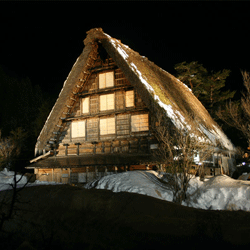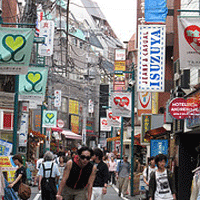Mar 26, 2013
HimakaJima in Sparkling Mikawa Bay
This article, and HimakaJima itself, caught my attention for various reasons:
- Chris Glenn knows where the good stuff in Japan is.
- It is a day trip from Nagoya.
- It is a day trip to an ISLAND. I like islands and oceans; though technically this is in a sea.
- The seafood is famous, but not so famous that most people have heard of it!
 If you are looking for a day trip destination to an island famous for beaches, resorts, sea food, and being close to Nagoya this is it. HimakaJima is less than an hour from Nagoya, and the food is better, according to Chris, a lot better than many more famous locations. The most famous offering is the octopus, but he claims the fugu, or poisonous puffer fish is better than that found in nearby Fukui Prefecture, despite its higher status in popular culture.
If you are looking for a day trip destination to an island famous for beaches, resorts, sea food, and being close to Nagoya this is it. HimakaJima is less than an hour from Nagoya, and the food is better, according to Chris, a lot better than many more famous locations. The most famous offering is the octopus, but he claims the fugu, or poisonous puffer fish is better than that found in nearby Fukui Prefecture, despite its higher status in popular culture.
From Chris’s article on Japan Tourist
Ask any Japanese where the biggest catch of fugu, the poisonous blowfish is made, and most will tell you Shimonoseki, or around Hiroshima, possibly even Fukui Prefecture on the Japan Sea Coast. Truth be known, the most fugu is caught off the waters of Aichi Prefecture, and one of the best places to enjoy the delicacy is Himakajima, a small island off the coast of the Chita Peninsula in Mikawa Bay,. The Meitetsu Railway company offers day tour packages including a 30 minute train ride from Nagoya Station to Kowa Station, followed by a 15 minute ferry ride from nearby Kowa Port.
For more information read the full article on Japan Tourist: Russian Roulette at Himakajima
Photo Courtesy of Japan Tourist
Mar 20, 2013
Takayama in Gifu Prefecture
Located in Gifu Prefecture, and  surrounded by some of Japan’s richest natural areas just below the famous Northern Alps, Takayama is some what isolated and distant. This isolation allowed the city to developed its own distinct culture that combines that of nearby Edo and Kyoto’s into a new and interesting way.
surrounded by some of Japan’s richest natural areas just below the famous Northern Alps, Takayama is some what isolated and distant. This isolation allowed the city to developed its own distinct culture that combines that of nearby Edo and Kyoto’s into a new and interesting way.
Takayama has a very traditional feel to it, and offers a wide variety of onsen hotels and guesthouses, local restaurants whose dishes are distinctly local; featuring traditional regional and local recipes made with local ingredients. While visiting you can see many historic buildings, or shop for local handcrafted arts, etc.
One thing not to miss is Shirakawago, a World Heritage Site located near Takayama. Shirakawago Village is famous for traditional houses called A Gasshō-zukuri style of traditional minka homes. Some of these traditional homes are hundreds of years old. This is especially impressive when you consider that the distinctive shape of the dwellings was developed over time to withstand the substantial weight of the heavy snow falls that all but lock in the village in winter; how many tons of snow has a 250 year old home had to bear? The roof of these homes are said to resemble hands clasped in prayer. From Takayama, day trips to Shirakawago to see its main attraction, Ogimachi, are popular, but according to Japan Guide, the best way to experience the town is to stay overnight at one of the farmhouses, many of which now serve as minshuku, or guest houses.
 One of my favorite cities in Japan, Takayama is particularly famous in the spring because the cherry blossoms really enhance the gorgeous old houses and small cobbled streets. You really need to book ahead if you are planning to travel around the busy times. A couple of friends however rolled up and were able to make themselves understood and were able to stay at the beautiful youth hostel housed in a temple, at very little notice last Obon. Website (Japanese only, but has map)If you’re wanting to stay in a Japanese guest house (anywhere, not just in Takayama), you might find this link useful: www.japaneseguesthouses.com
One of my favorite cities in Japan, Takayama is particularly famous in the spring because the cherry blossoms really enhance the gorgeous old houses and small cobbled streets. You really need to book ahead if you are planning to travel around the busy times. A couple of friends however rolled up and were able to make themselves understood and were able to stay at the beautiful youth hostel housed in a temple, at very little notice last Obon. Website (Japanese only, but has map)If you’re wanting to stay in a Japanese guest house (anywhere, not just in Takayama), you might find this link useful: www.japaneseguesthouses.com
It takes a little more than two hours on the train from Nagoya, the nearest Major city, and about the same by car. It’s certainly a very beautiful trip as well. From Takayama, there are endless possibilities for hot springs, most featuring outdoor baths that look up into the mountains.
Posted by First Admin in Travel at 06:56 | Comments (0) | Trackbacks (4412)
Mar 14, 2013
Let’s Tour the Metropolis: Shimo-Kitazawa
This is the first in a series of articles that will introduce some of the neighborhoods that make up the Tokyo Metropolis Area. It’s my goal to try to cover areas that don’t get as much limelight in the traveler’s guides, or that have a lot of hidden treasures in them.
Shimo-Kitazawa has been called “Tokyo’s answer to Greenwich Village, Haight-Asbury, Camdentown,” and any other funky, eclectic neighborhood you can think of around the globe. Located west of Shibuya and Shinjuku in Setagaya Ward, many of it’s residents would also tell you that it’s what trendy districts like Harujuku used to be like, before the ‘bubble years’ and commercialization happened. True, Shimo-Kitazawa is a lot less hectic than those other districts and it’s outside of the Yamanote Loop that denotes ‘central Tokyo’ from the outskirts of town (albeit only on a mental level), but that’s what makes this little district so vibrant–spontaneity made it happen in the first place.
Because of it was a semi-rural area at the time, it was spared from Allied bombing raids during WWII. During and after the occupation years, it became an area where surplus American goods could be bought and traded. Then during the 1960’s Shimo-Kitazawa became the home for those wishing to ‘make love, not war’; It’s here that the Japanese hippie movement got it’s legs and many of those same folks who were in that group now own and run a lot of the music bars, live houses, and other assorted businesses that make up the neighborhood. These days, most young people when asked, usually list ‘Shimokita’ as it’s referred to, as a top spot to live and hang out. It’s proximity to Meiji University makes it an ideal ‘college town’, but many well-established Tokyoites call this place home too.
The other reason ‘Shimokita’ is so popular is proximity. It’s the neighborhood surrounding the train station of the same name on both the Odakyu and Keio Inokashira lines. All trains on both lines except limited expresses stop here, making for a smooth, quick journey to/from Shinjuku or Shibuya in under 20 minutes. In fact, Odakyu is moving their operations underground on March 23, 2013 and will also be adding capacity, so this area will be that much sought after in the future.
So what kind of places make up Shimo-Kitazawa?
There are vintage and retro stores galore here. Places like Lotty and High&Low specialize in clothing and are just two of the dozens of shops around.
Cafes and bars small enough to make a mouse claustrophobic are also numerous as well. My two faves? Palazzo because of it’s cheap delicious eats (There’s literally a plate with curry, spaghetti with tomato sauce and hamburger steak… For ¥500!) and great desserts. Open Source Café is where the area’s young technophiles come to nerd out and get work done during the day. They offer all-day wi-fi and power for your laptop, tablet, or phone along with a drink for ¥1000. They also play host to a lot of Tokyo’s tech meet-ups as well.
Lastly, Shimo-Kitazawa has a great underground music and arts scene. It is home to the historic Honda Gekijō theater building along with a large number of dive bars and live houses that play host to almost anyone that can hold a note and pluck a guitar. Places like Mosaic, Garden and Three, are some of the joints where you could be watching the next breakout artist in Japan perform.
If you’re needing a break from the norm of hopping the Yamanote Line looking for something to do one day, make your way westward to Shimo-Kitazawa and indulge yourself in some of Japan’s bohemian spirit.
ACCESS
Shimo-Kitazawa station on the Odakyū Odawara and Keiō Inakashira lines.





